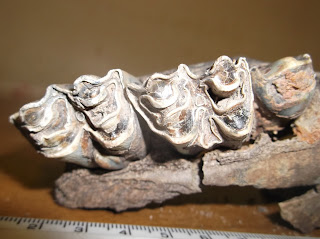 1 - This image shows most of the separate geological layers we now walk on in the south west of Cleveland,from top to bottom we have 1 metre + of stoneless alluvium with no fossil content, next a blue grey sandy clay deposit 100- 150 mm thick . then the Stainton gravel bed 300 mm thick and rich in preserved bone & older fossils & minerals marked with the black outline, then a red brown plastic clay averaging 1m thick.
1 - This image shows most of the separate geological layers we now walk on in the south west of Cleveland,from top to bottom we have 1 metre + of stoneless alluvium with no fossil content, next a blue grey sandy clay deposit 100- 150 mm thick . then the Stainton gravel bed 300 mm thick and rich in preserved bone & older fossils & minerals marked with the black outline, then a red brown plastic clay averaging 1m thick. 2 - This image shows the layer that sits directly above the Stainton gravel beds 100 to 150 mm grey blue layer of sandy organic clay, containing large amounts of what looks to be high grade coal fragments probably Anthracite.
2 - This image shows the layer that sits directly above the Stainton gravel beds 100 to 150 mm grey blue layer of sandy organic clay, containing large amounts of what looks to be high grade coal fragments probably Anthracite. 3 - This image shows three of the lower deposits, bright red clay layer to the top averaging 50 - 60 mm thick, bright blue clay layer again averaging 50 - 60 mm thick.
3 - This image shows three of the lower deposits, bright red clay layer to the top averaging 50 - 60 mm thick, bright blue clay layer again averaging 50 - 60 mm thick.
(a) Yellow outline = Alluvium 1 metre = thick with no visible stone content small coal pieces probably Anthracite. High magnetic content smaller sandy grains extremely magnetic.
(b) Black outline = blue - grey sandy deposit 150 - 160 mm thick containing small coal pieces probably anthracite. High magnetic content.
(c) Red outline = Stainton gravel bed average thickness 300mm, containing preserved organic material, and a high magnetic content.
(d) Red brown plastic clay with visible stone content, and Jurassic fossils, low magnetic content.
 7 - Black outline = red brown plastic clay as show in image 6, with visible stone content both rounded and angular, also Jurassic marine fossils. Low magnetic content.
7 - Black outline = red brown plastic clay as show in image 6, with visible stone content both rounded and angular, also Jurassic marine fossils. Low magnetic content.
(a) Yellow outline = Very bright red clay 50-60mm thick containing what looks to be very small pieces of Mercia mudstone ( red ) as well as small rounded and angular stone, Low magnetic content.
(b) Red outline = Very bright blue clay 50-60 mm thick no visible stone content, No magnetic content .
(c) Black outline = Red - brown plastic clay - no magnetic content,
visible stone content.
The bed rock below these deposit is Triassic Mercia mudstone, and all of the deposits i have tested in the south west of Cleveland, have shown no signs of any magnetic content, this strongly points towards the uppermost Holocene superficial deposits being the source of the magnetic content. I have tried to identify possible surrounding areas for the origins of the Anthracite pieces in the Holocene deposits, but have found nothing definite yet.
Related posts

















































 10 - This image show modern red deer antlers.
10 - This image show modern red deer antlers.